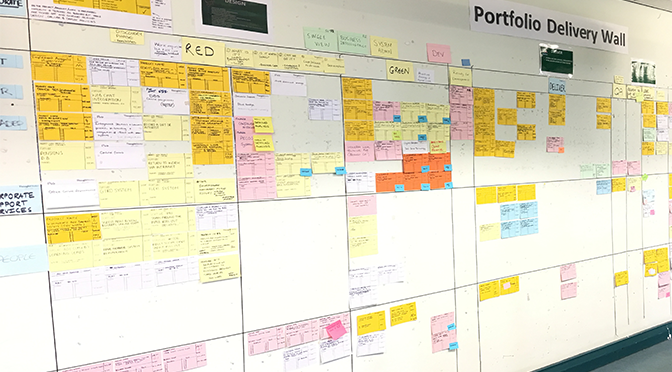Collaboration and communication are at the heart of Agile ways of working, so it’s somewhat ironic that agile terminology like ‘kanban’ and ‘standups’ can inadvertedly put up barriers. In this blog I aim to bust some agile jargon and show some simple steps you can take to become agile yourself.
If you’re feeling unsure where to start or even if it’s relevant to a non-tech environment, please don’t be put off, look at these simple tips and make a start.
Firstly, you don’t have to be working on an agile or tech project like Digital by Design to be agile. And you don’t need permission to try out some of the agile tools and thinking. After all, it’s just you being more responsive, productive and flexible in how you work, so who could object?
Start small
Start with yourself, or your immediate team if you don’t yet have wider buy-in. Try a few things and get feedback. Then use that feedback to improve what you do. If the scale of work is daunting, break it down into smaller chunks and tackle it incrementally, adapting as you go.
Only do work that adds value – Look at what you do now, the processes you have in place and the documents or products you produce. Is there value in all of them? Ask yourself whether bits could be trimmed down or even cut out altogether. Is there something of greater value that’s missing? I find ‘Agile’ can be quite liberating in this way. It’s your chance to ‘cut the crap’ as my old boss Greg Dyke, the ex-Director General of the BBC, used to say. Stand up and challenge the things that aren’t working for you or your stakeholders and don’t add positively to your goals.
Prioritise
Don’t try to take on everything at once. Focus on what delivers the most value. Work with your customers or other stakeholders to find out what pieces of work they value the most. If you start with getting these right you won’t go far wrong.
Communicate
Transparency is key too so make what information you want to convey as visible and as unambiguous as possible. Display it so you have opportunity to discuss it regularly rather than waiting for weekly, monthly or quarterly meetings. Agile methodology encourages daily meetings known as ‘stand ups’ because they are short (usually no more than 15 minutes in length), focused gatherings that don’t require table, chairs or even a meeting room. Standups encourage regular interactions to aid collaboration and decision making.
All key people should attend (although it’s open to anyone with an interest) and gather around a ‘kanban board’ which is a tool that both sets the agenda and charts progress in one. Kanban, which roughly translates as ‘card you can see’, relates to work being made visible and the principle that it should be timed to occur just as it is needed. The concept is that actions occur as they are triggered by other actions and events. So, for example a ‘re-stock goods’ action would only trigger once those items have been purchased. Hence the Kanban shows an order or process through which actions flow. Getting stakeholders together regularly around a board will help you understand one another better and quickly deal with anything that’s blocking progress.
Don’t be daunted when you see other, complex-looking Kanban boards. Instead, think of what you or your team needs to see and what progress you value and start from there. And in truly agile fashion, add to it and adapt as you go, but the important thing is to make a start.
Fail fast
Don’t be afraid of trying new things. If bits of it work, learn from it and keep adjusting till it improves. The key is not to spend too long building up to trying something new and challenging. If you’re going to try it, try it as soon as you can and if it doesn’t work you haven’t committed too much resource if you need to scrap it. A failed idea is NOT the same as ‘failure’ so long as you fail fast and learn from it. Once leaders and members of staff no longer fear trying something new and embrace challenges in an agile way we will truly be a progressive council.
I know what you’re thinking. Much of what I’ve said is just common sense. Yes, agile does make sense, but the only thing common about it is how often that is overlooked. So now you know agile is not rocket science; what are you waiting for? Just do it!


Excellent article with practical hints and tips. Going to see what I can adapt for my world. Thanks Lee